By Kate Dietrick
Archivist, Nathan and Theresa Berman Upper Midwest Jewish Archives
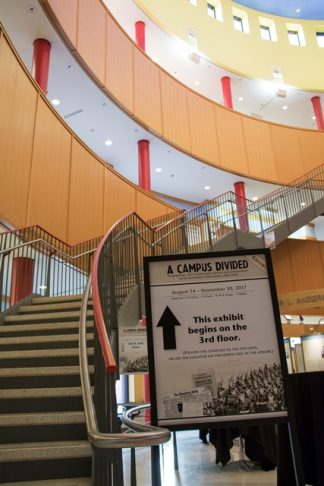
The exhibit “A Campus Divided” was on display on the
third and second floor of Elmer L. Andersen Library
from August to December of 2017.
On August 14, the exhibit A Campus Divided: Progressives, Anti-Communists, Racism, and Antisemitism at the University of Minnesota, 1930-1942 opened on the second and third floors of Elmer L. Andersen Library.
Pulling from materials in the University Archives, Upper Midwest Jewish Archives, Minnesota Historical Society, local newspapers, and more, the exhibit was a culmination of years of original research by co-curators Riv-Ellen Prell and Sarah Atwood.
My involvement, as archivist for the Upper Midwest Jewish Archives, goes back over three years. When I first took up my position in March 2013, I befriended Professor (now Emeritus) Riv-Ellen Prell, who was at the time director of the Center for Jewish Studies here on campus. In conversation, she asked what, if anything, we had in the Upper Midwest Jewish Archives that related specifically to antisemitism on the University of Minnesota campus.
I told her we didn’t have much — I had anecdotal stories from community members but no concrete evidence of acts of antisemitism by the University administration. But I encouraged her to research the topic, and should she find ample resources, we could mount an exhibit in Andersen Library.
At the 2014 annual meeting of the Center for Jewish Studies, Riv-Ellen announced the research project as a goal for the coming years, and from that point we were off on the journey. The topic grew as Riv-Ellen brought on Sarah Atwood, a Ph.D. candidate in American Studies, and through research they uncovered documentation in the archives of blatant racism and antisemitism on campus, along with surveillance of progressive students. On my end, I helped facilitate research and coordinated with our exhibit designer Darren Terpstra to get the exhibit designed, mounted, and publicized.
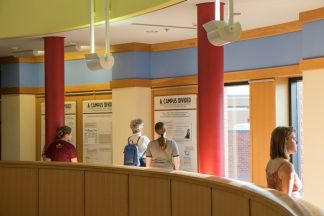
Visitors taking in the exhibit “A Campus Divided” at
Elmer L. Andersen Library
By the time the exhibit went up in August, the topic had been with us for three years and I had completely lost perspective. Would anyone else find A Campus Divided interesting? We had built it, would they come?
Attention for the A Campus Divided was beyond anything we had experienced before, as thousands of people flocked to Andersen Library to view the exhibit. Not only did news coverage appear in nearly every local paper, but the opening event and talk was held to a sold-out attendance of over 180 attendees. As voices surged to respond to what had been uncovered, University President Eric Kaler issued an official statement that addressed the exhibit and called for the President’s and Provost’s Advisory Committee on University History. The committee has been meeting since November and is expected to release their recommendations in February.
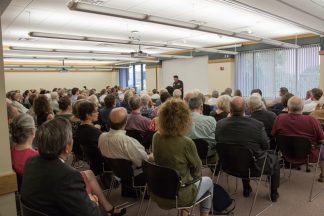
Professor John S. Wright speaking during the opening
event for the exhibit “A Campus Divided”
on September 13, 2017.
The exhibit was extended into December, and during the four months that it was up I gave personal tours to 331 students and community members.
Riv-Ellen gave tours as well, including to prominent community members and members of the University’s Board of Regents. Countless faculty members brought their students to view the exhibit — courses from Media Ethics to Historical Methods — and tied the topics uncovered in the exhibit into their curriculum, discussing and debating the difficult history with undergraduate and graduate level students.
Groups of people came in droves: campus-based administrators, student leadership groups, local college staff members taking the light rail over during their lunch hour, high school teachers visiting during MEA break, community book clubs, and cultural clubs looking to learn more.
The conversations that came out of the exhibit were, to me, the most powerful. To have people from various backgrounds talking openly about racism on campus, both past and present, and how that might affect students and the community at large — it was a reckoning that was a long time coming.
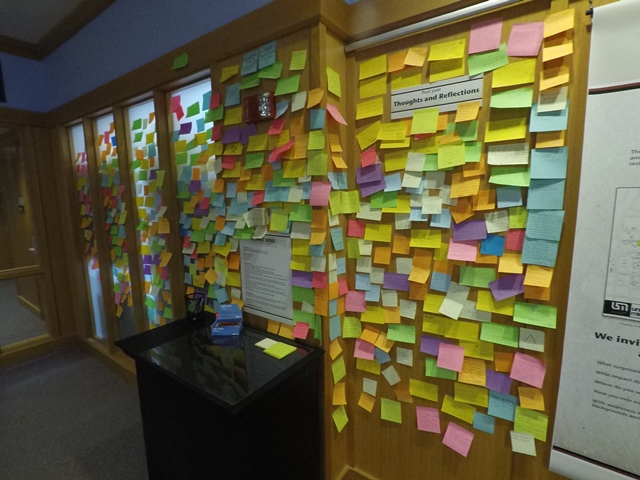
Post-it notes left as thoughts and reflections at the end of the exhibit “A Campus Divided”
When the exhibit closed at the end of December, we removed the post-it note comments that had been left at the end of the exhibit. All told, 565 post-it note comments were left by community members who wanted to share their thoughts and reflections. The comments were typed up and presented to the University History committee as documentation of the community’s feedback on what they had learned. A word cloud gives us an idea of the overarching themes of their reflections:
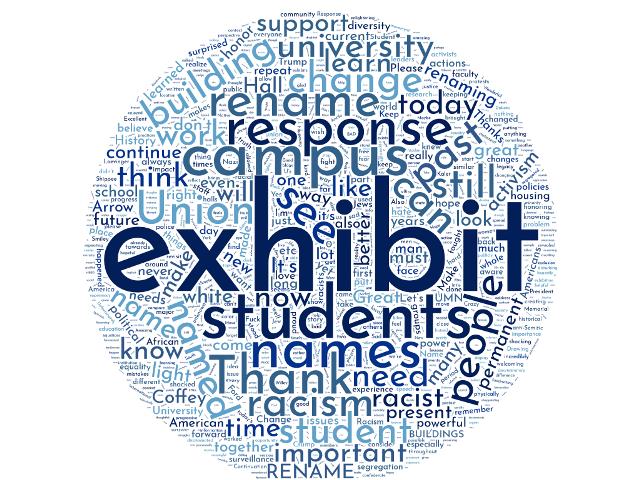
A word cloud pulling from the comments taken from the 565 post it notes left at the end of the exhibit.
As I look back, what I enjoyed most about this exhibit was that it showcased the power of the archives. In nearly every popular culture article written about archives, you cannot get through the first paragraph without words like dusty, musty, or old.
The stereotypes these words conjure up irk me to no end, because they position the archives as a stagnant, passive relic, and not the vibrant, active hub that I encounter every day. This exhibit illustrated perfectly how history, in particular primary source research conducted in the archives, can have a relevant and powerful impact on our present day lives.
There is a reason we painstakingly keep archival materials: the documents we safeguard tell stories that can influence not only the way we see the past but the way we envision the future. This exhibit reminded me of the value of uncovering the histories of the past and the discussions that can stem from this. And I look forward to seeing how this discussion hopefully continues to unfold, even after this exhibit is down.
The exhibit is still available online — visit acampusdivided.umn.edu to learn more.




